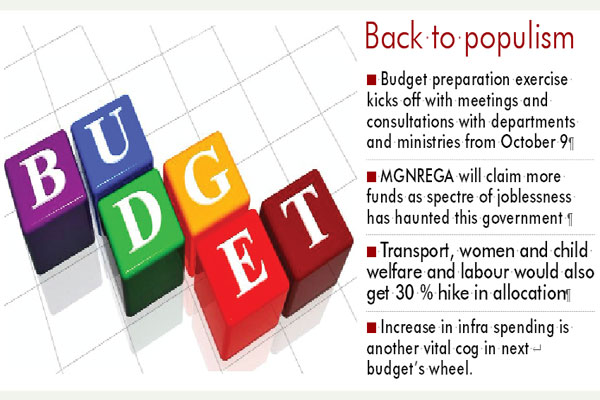
Finance minister Arun Jaitley’s 2018-19 Union budget, this BJP government’s last, will not shy away from committing higher expenditure for populist social sector schemes.
Expectations include a minimum 30 per cent increase in annual allocation for agriculture, rural development, education and infra sectors and an all time high support for employment guarantee scheme MGNREGA.The budget preparation exercise kicks off with meetings and consultations with departments and ministries from October 9.
Official sources say that traditionally, pre-election Union budgets are populist where fiscal prudence goes for a six, but the government also has to do the balancing act to ensure that the growth momentum is retained in the economy after it fell to 5.7 per cent in April-June quarter.
This has to be done in tandem with mobilising adequate funds to sufficiently finance schemes that affect a large section of the vote bank and helps the government get a positive pro-welfare image.
“Though fiscal prudence could limit the government’s expenditure goals for the next year, sufficient funds would be provided for social sector schemes that did not receive a big increase in allocation this year, as compared to revised estimates of the previous year. This could allow the government the room to increase expenditure on some social sector schemes by up to 30 per cent,” said an official privy to the development.
Rural employment measures like MGNREGA will claim more funds as the specter of joblessness has haunted this government for while.
The finance minister had allocated Rs 48,000 crore for MGNREGA, the highest ever funding since its roll out 10 years ago in this year’s budget.
The allocation to the rural development ministry was also increased by more than 10 per cent to Rs 1,07,758 crore.
Sources said the MGNREGA and the rural development ministry would get a minimum 25 per cent increase in FY19 allocation to carry forward populist schemes in rural areas. Transport, women and child welfare, power, labour and skill development would get higher allocation of 30 per cent, sources said, adding these are job-creating industries that would get government support.
The government has faced fierce criticism over its inability to create jobs in over three- and-a-half years of its rule. The finance minister is also likely to address the farm sector's concerns by allocating more funds. This year, the total allocation for agriculture and allied sectors is pegged 24 per cent higher at Rs 1,87,223 crore.
But the sector is facing a crisis with expectations of sharp fall in growth in FY18, making a budgetary hike of 30 per cent in FY19 imminent, sources said.
In the current budget, the government is in the process of expanding the coverage of Pradhan Mantri Fasal Bima Yojana (PMFBY). It is expected to be increased from 30 per cent of the cropped area in 2016-17 to 40 per cent in 2017-18 and 50 per cent in 2018-19.
For this, a provision of Rs 9,000 crore has been made, which is likely to be enhanced for the 2018-19 budget.
The current allocation for agriculture and farmers welfare is Rs 35,984 crore and will also come up for revision, sources added.
Indian agriculture sector accounts for 17 per cent of India's gross domestic product (GDP) and engages almost 50 per cent of the country's workforce. The target for agricultural credit in 2017-18 has been fixed at a record level of Rs 10 lakh crore. This may also see an increase by another 25 per cent in budget FY19.
Welfare schemes like Deendayal Antodaya Yojana- National Rural Livelihood Mission for promotion of skill development and livelihood opportunities for people in rural areas, which has a budget of Rs 4,500 in 2017-18, will be upped to create more job oriented youth leading to job creation itself.
While the government would have to weigh the consequences of a higher than expected fiscal deficit (target for FY19 is 3 per cent of GDP at present) with increased spending, it would be comfortable in terms of funding as the social sector budget for 2016-17 did not see a big increase over the revised estimates for 2016-17. So an increase over low base budget estimates of current year for FY19, would be less painful.
In addition, the government is working out ways to raise non-tax revenues like dividends, PSU profits, revenue receipts and spectrum auction receipts to it to keep the next year's fiscal deficit within the target of 3 per cent even on higher expenditure, sources said.
The increase in infrastructure spending by the government is another vital cog in the next budget’s wheel.



